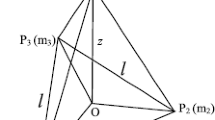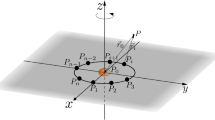Abstract
This paper is extension to the classical Sitnikov problem, when the four primaries of equal masses lie at the vertices of a square for all time and moving in elliptic orbits around their center of mass of the system, the distances between the primaries vary with time but always in such a way that their mutual distances remain in the same ratio. First we have established averaged equation of motion of the Sitnikov five-body problem in the light of Jalali and Pourtakdoust (Celest. Mech. Dyn. Astron. 68:151–162, 1997), by applying the Van der Pol transformation and averaging technique of Guckenheimer and Holmes (Nonlinear oscillations, dynamical system bifurcations of vector fields, Springer, Berlin, 1983). Next the Hamiltonian equation of motion has been solved with the help of action angle variables \(I\) and \(\phi\). Finally the periodicity and stability of the Sitnikov five-body problem have been examined with the help of Poincare surfaces of section (PSS). It is shown that chaotic region emerging from the destroyed islands, can easily be seen by increasing the eccentricity of the primaries to \(e = 0.21\). It is valid for bounded small amplitude solutions \(z_{\mathrm{max}} ( z_{\mathrm{max}} = 0.65 )\) and \(0 \le e < 0.3\).



Similar content being viewed by others
References
Belbruno, E., Llibre, J., Olle, M.: On the families of periodic orbits which bifurcate from the circular Sitnikov motions. Celest. Mech. Dyn. Astron. 60, 99–129 (1994)
Berdichevsky, V., Ozbek, O., Kim, W.W.: Thermodynamics of Duffing’s oscillator. ASME J. Appl. Mech. 61, 670–675 (1994)
Brouwer, D., Clemence, G.M.: Methods of Celestial Mechanics. Academic Press, New York (1961)
Conley, C.C.: On the ultimate behaviour of orbits with respect to an unstable critical point I, oscillating, asymptotic and capture orbits. J. Differ. Equ. 5, 136–158 (1969)
Chasley, S.R.: A global analysis of the regularized Sitnikov problem. Celest. Mech. Dyn. Astron. 73, 291–302 (1999)
Corbera, M., Llibre, J.: Periodic orbits of the Sitnikov problem via a Poincare map. Celest. Mech. Dyn. Astron. 77, 273–303 (2000)
Davis, H.T.: Introduction to Nonlinear Differential and Integral Equations. Dover, New York (1962)
Douskos, C., Kalantonis, V., Markellos, P., Perdios, E.: On Sitnikov-like motions generating new kinds of 3-d periodic orbits in the restricted three-body problem with prolate primaries. Astron. Astrophys. 337, 99–106 (2012)
Dvorak, R., Sun, Y.S.: Phase space structure of the extended Sitnikov problem. Celest. Mech. Dyn. Astron. 67, 87–106 (1997)
Faruque, S.B.: Axial oscillation of a planetoid in the restricted three-body problem: the circular case Sitnikov problem. Bull. Astron. Soc. India 30, 895–909 (2002)
Faruque, S.B.: Solution of the Sitnikov problem. Celest. Mech. Dyn. Astron. 87, 353–369 (2003)
Guckenheimer, J., Holmes, P.: Nonlinear Oscillation, Dynamical System Bifurcations of Vector Fields. Springer, Berlin (1983)
Hagel, J.: A new analytical approach to the Sitnikov problem. Celest. Mech. Dyn. Astron. 53, 267–292 (1992)
Jalali, M.A., Pourtakdoust, S.H.: Regular and chaotic solutions of the Sitnikov problem near the 3/2 commensurability. Celest. Mech. Dyn. Astron. 68, 151–162 (1997)
Lara, L.J., Buendia, A.E.: Symmetries and bifurcations in the Sitnikov problem. Celest. Mech. Dyn. Astron. 79, 97–117 (2001)
Liu, J., Sun, Y.S.: On the Sitnikov problem. Celest. Mech. Dyn. Astron. 49, 285–302 (1990)
MacMillan, W.D.: An integrable case in the restricted problem of three-body. Astron. J. 27, 11–13 (1913)
Moser, J.: Stable and Random Motions in Dynamical System. Princeton University Press, Princeton (1973)
Pandey, L.P., Ahmad, I.: Periodic orbits and bifurcation in the Sitnikov four-body problem when all the primaries are oblate. Astron. Astrophys. 345, 73–83 (2013)
Pavanini, G.: Sopra una nuova categoria di soluzioni periodiche nel problema di tre corpi. Annali di Mathematica Pura ed Applicata, serie iii, vol. xiii, pp. 179–202 (1907)
Perdios, E.A.: The manifolds of families of 3-D periodic orbits associated to Sitnikov motions in the restricted three-body problem. Celest. Mech. Dyn. Astron. 99(2), 85–104 (2007)
Perdios, E.A., Kalantonis, V.S.: Self-resonant bifurcations of the Sitnikov family and the appearance of 3-D isolas in the restricted three-body problem. Celest. Mech. Dyn. Astron. 113, 377–386 (2012)
Perdios, E., Markellos, V.V.: Stability and bifurcations of Sitnikov motions. Celest. Mech. Dyn. Astron. 42, 187–200 (1988)
Rahman, M.A., Garain, D.N., Hassan, M.R.: Solution and stability of Sitnikov restricted three-body problem when the primaries are sources of radiation int. J. Appl. Math. Mech. 10(11), 21–36 (2014)
Shahbaz Ullah, M., Hassan, M.R.: Connection between three-body configuration and four-body configuration of the Sitnikov problem when one of the masses approaches zero: circular case. Astron. Astrophys. 353(1), 53–64 (2014a)
Shahbaz Ullah, M., Hassan, M.R.: Sitnikov cyclic configuration of \(N + 1\)-body problem. Astron. Astrophys. 354(2), 327–337 (2014b)
Shahbaz Ullah, M., Bhatnagar, K.B., Hassan, M.R.: Sitnikov problem in the cyclic kite configuration. Astron. Astrophys. 354(2), 301–309 (2014)
Shahbaz Ullah, M., Majda, B., Zafar Ullah, M., Shahnawaz Ullah, M.: Series solutions of the Sitnikov restricted \(N + 1\)-body problem: elliptic case. Astron. Astrophys. 357(2), 1–9 (2015)
Sitnikov, K.A.: Existence of oscillating motion for the three-body problem. Dokl. Akad. Nauk SSSR 133(2), 303–306 (1960)
Soulis, P.S., Bountis, T., Dvorak, R.: Stability of motion in the Sitnikov three-body problem. Celest. Mech. Dyn. Astron. 99, 129–148 (2007)
Soulis, P.S., Papadakis, K.E., Bountis, T.: Periodic orbits and bifurcations in the Sitnikov four-body problem. Celest. Mech. Dyn. Astron. 100, 251–266 (2008)
Stumpff, K.: Himmelsmechanik, band ii, pp. 73–79. Veb Deutscher Verlag der Wissenschaften, Berlin (1965)
Suraj, M.S., Hassan, M.R.: Sitnikov problem: it’s extension to four-body problem. Proc. Pac. Acad. Sci. 48(2), 117–126 (2011)
Suraj, M.S., Hassan, M.R.: Solution of Sitnikov restricted four-body problem when all the primaries are oblate bodies: circular case. Proc. Pac. Acad. Sci. 50(1), 61–69 (2013)
Suraj, M.S., Hassan, M.R.: Sitnikov restricted four-body problem with radiation pressure. Astron. Astrophys. 349, 705–716 (2014)
Suraj, M.S., Hassan, M.R., Bhatnagar, K.B.: Averaging the equation of motion of Sitnikov restricted four-body problem. Glob. Sci. Technol., 17–22 (2010a)
Suraj, M.S., Hassan, M.R., Bhatnagar, K.B.: Sitnikov problem: its extension to four-body problem when all the primaries are source of radiation pressure. Glob. Sci. Technol., 158–164 (2010b)
Acknowledgements
The author is very grateful to the referee for his constructive comments to revise the manuscript. The author also thankful to C.F.R.S.C. for giving academic support for this research work.
Author information
Authors and Affiliations
Corresponding author
Appendix
Appendix
First we expand the right hand side of Eq. (2) and then by putting the values of \(r_{1} ( t ), r_{2} ( t ), r_{3} ( t ),\ldots\) . in the same equation, we get
Multiplying \(z\) on both sides and applying the Binomial theorem, we get
Solving the above equation and taking the terms proportional to \(e^{\alpha'}z^{\alpha''} ( \alpha' + \alpha'' \le5 )\), we get
Let us transform the higher power of the cosine function in linear form as
Putting the semi major axis \(a = 1/\sqrt{2}\) in the above equation one can find \(\varpi^{2}\) and \(f_{1} ( t )\).
Following the same procedure for the third term of Eq. (3), one can easily find \(f_{2} ( t )\).
Rights and permissions
About this article
Cite this article
Shahbaz Ullah, M. Sitnikov problem in the square configuration: elliptic case. Astrophys Space Sci 361, 171 (2016). https://doi.org/10.1007/s10509-016-2654-y
Received:
Accepted:
Published:
DOI: https://doi.org/10.1007/s10509-016-2654-y




